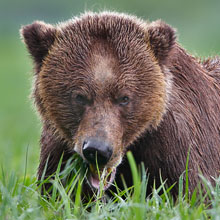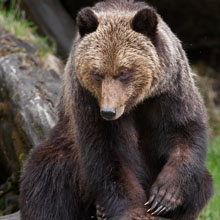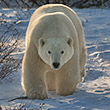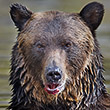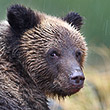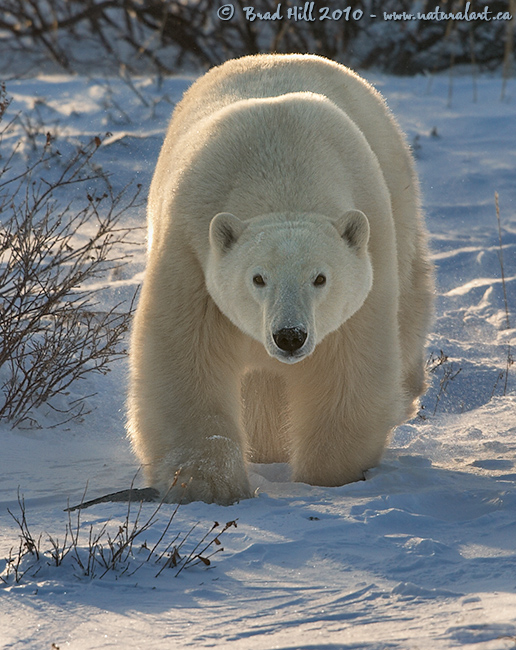
Availability: Undetermined - Enquiries?
In the Field
Predatory Perfection. Cape Churchill, Manitoba, Canada. October 26, 2004.
This shot aged a little between capture date and processing date - shot in 2004 and processed in 2010! While I'd like to argue that a good RAW image is like a good bottle of rum (and improves with age), I suppose there's no way around admitting that my workflow sprung a leak in this case! But, on the positive side, RAW processing software has improved so much since 2004 that by waiting until 2010 I avoided wasting the time of processing the image twice (once in 2004, then again once I realized how much better the image would look if processed with more current software!).
The "perfection" in the title of this image refers to the bear, not my photographic skills! While the beautiful back/sidelighting (look at the direction of the bear's shadow to determine the direction of the main lighting source) under which I shot this image made for a bit of a tricky exposure, the bigger challenge in was in processing this image. Like with many shots with tricky lighitng, I processed this by making several different RAW conversions (each with a different exposure adjustment) and then composited the resulting files in Photoshop. I find this method gives me far more control over the nuances of the exposure than simply trying to adjust shadow/highlight detail on a single image. The biggest trick with this image was to bring out just enough details out of the shadows (which was the entire front of the bear) to show off the beautiful detail in this amazing predators pelage but not brightening the shadows so much that the final image looked unnatural. Final tone tweaking and tone mapping was performed using a little known piece of software called "LightZone" (from Light Crafts Software) which I'm liking more and more all the time! In this case the look of the fur on the front side of the bear's legs is almost entirely owing to how I was able to re-balance the subtle tones in the fur (using LightZone).
The subject of this bear's stalk? Oh, that was me (and there IS a bear story behind that statement!). But, given I'm writing this in early 2010, it's apparent I survived. And, I'm hoping this specific perfect predator is still out there doing its thing!
Behind the Camera
Predatory Perfection. Cape Churchill, Manitoba, Canada. October 26, 2004.
Digital Capture; Compressed RAW (NEF) 12-bit format; ISO 200.
Nikon D2H with Nikkor 200-400 mm f/4G ED-IF AF-S VR lens @ 400mm (600 mm EFL) - handheld. VR on and set to "Normal" mode.
1/200s @ f6.3; +0.33 stop compensation from matrix-metered exposure setting of camera.
At the Computer
Predatory Perfection. Cape Churchill, Manitoba, Canada. October 26, 2004.
RAW Conversion to 16-bit TIFF using Phase One's Capture One Pro 5. Four RAW conversions at different exposure settings. Exposure settings of -0.33 stops (to retrieve highlight detail on back of bear) through to +0.55 stops (to retrieve shadow detail on head and front legs of bear).
Further digital corrections on 16-bit TIFF file using Adobe's Photoshop CS4 and Light Craft's LightZone. Photoshop adjustments included compositing and masking of 4 exposure versions, selective saturation abd de-saturation of colours, and selective sharpening for web output. Final tonemapping, balancing and tweaking performed using the Tonemapper/Re-light tool in LightZone.
Conservation
Predatory Perfection. Cape Churchill, Manitoba, Canada. October 26, 2004.
Ten percent of the revenue generated by this image will be donated to the Yellowstone to Yukon Conservation Initiative.
Species Status in Canada*: Special Concern (November 2002).
Polar Bears (Ursus maritimus) are the largest terrestrial carnivores on the planet and the most carnivorous of all bears. They are highly specialized and feed almost exclusively on Ringed Seals. Polar Bears hunt their prey from ice sheets and are dependent upon these ice sheets for their survival.
Like any highly-specialized organism, Polar Bears are highly susceptible to habitat alteration. Climate change - natural or human-induced - is probably the greatest long-term threat to Polar Bear survival. The longer ice-free seasons experienced in the southern reaches of their distribution is already making it difficult for them to hunt.
The Yellowstone to Yukon (Y2Y) Conservation Initiative seeks to ensure that the world-renowned wilderness, wildlife, native plants, and natural processes of the Yellowstone to Yukon region continue to function as an interconnected web of life, capable of supporting all of its natural and human communities, for current and future generations.
For more information on the status of Polar Bears in Canada, go to: http://www.speciesatrisk.gc.ca and search under "Polar Bears".
*as determined by COSEWIC: The Committee on the Status of Endangered Wildlife in Canada


















